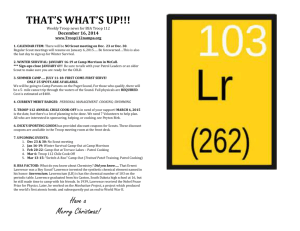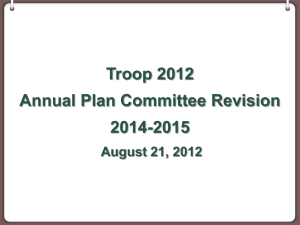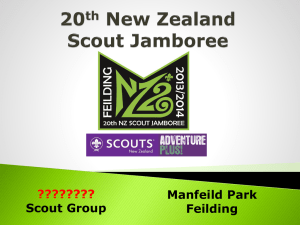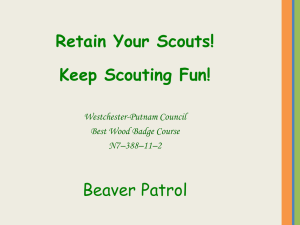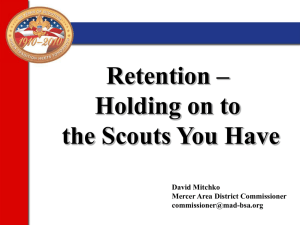Troop 230 First Class Emphasis Program Overview
advertisement
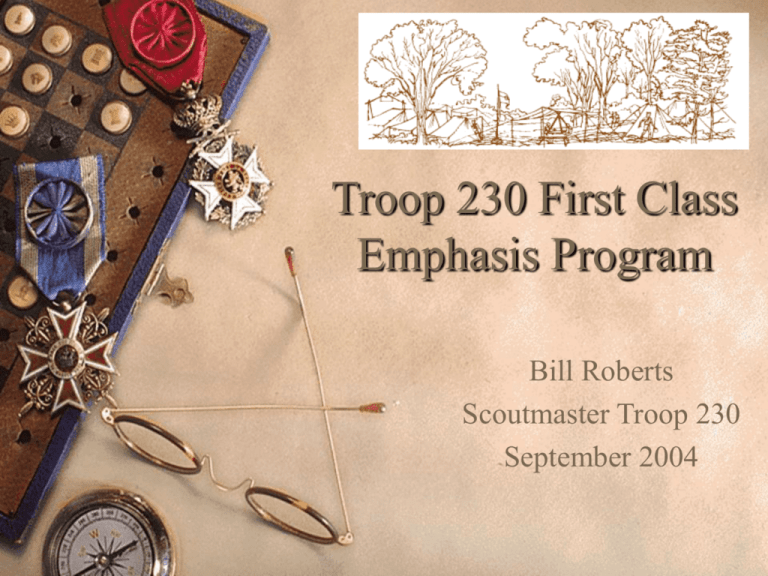
Troop 230 First Class Emphasis Program Bill Roberts Scoutmaster Troop 230 September 2004 First Class Emphasis Program A specific Troop Program that focuses on new Scout development and opportunity for advancement to First Class within the first year From the Scoutmaster Handbook: “A boy who advances to First Class within his first year in Scouting has a better-than-average chance of eventually becoming an Eagle Scout.” BSA Statistics also confirm the Scout is likely to stay in Scouting for a longer period of time. Elements of the FCE Program Assistant Scoutmaster (ASM) for each new patrol – an involved & trained Scouter to work with another adult Mentor Specific program that provides the opportunity for Advancement to First Class within the first year For new scout patrols & new scouts Troop Guides assist new patrols – provide skills development coaching Patrols stay together for at least first year, usually longer Focus learning through outdoor programs (80%) and hands on activities Scouts can work on Tenderfoot, Second Class, and First Class advancements in parallel (also merit badges at summer camp) FCE is fun! Tenderfoot Second Class First Class FCE Program Requires Attendance Campouts – camping, cooking, hiking, nature, orienteering, knot/lashing, wood tool Patrol Meetings for e.g. Swimming Skills, Patrol Flag/Yell, Orienteering Troop Meetings for Other Skills – – – – Citizenship Personal Fitness First Aid Service/Scout Spirit Summer & Winter Camp Good Opportunity for Merit Badges New Scout Patrol Chooses Program An experienced ASM will help the new patrol (usually the Adult Guide Coordinator), but PATROL sets program New Scout ASM’s are Key Individuals (minimum 2) Alternate ASM is Highly Recommended Communication by ASM’s to Scouts & Adults Important Use Troop Camp plan, set objectives for each Camp, use Fewer Outside Patrol Meetings OR Less Camp Planning, More Outside Patrol Meetings In Either Case, Consult with Guides and Guide Coordinator at Troop/Patrol Meetings and Camps to assist Attendance and Attention is Needed from Scouts and the New Scout ASM’s for a Scout to be First Class in 1 Year. FCE Campout Theme: Getting Started This can be the first requirements completed by the FCE scouts on a Troop campout. 1. Present yourself to your leader, properly dressed, before going on an overnight camping trip. Show the camping gear you will use. Show the right way to pack and carry it. 2. Spend at least one night on a patrol or troop campout. Sleep in a tent you have helped pitch. 3. On the campout, assist in preparing and cooking one of your patrol's meals. Tell why it is important for each patrol member to share in meal preparation and cleanup, and explain the importance of eating together. 7. Repeat from memory and explain in your own words the Scout Oath, Law, motto, and slogan. 8. Know your patrol name, give the patrol yell, and describe your patrol flag. 9. Explain why we use the buddy system in Scouting. Preparation (Troop AND Patrol Meetings Suggested) – Work with FCE Scouts during monthly preparation meetings on on Oath, law, motto and slogan – Work this in conjunction with SM on early campout – Troop Guide to work with FCE Patrol PL/APL to create duty roster during month insuring all Scouts assist in meal preparation – Troop Guide to help facilitate FCE Scouts determining Patrol name, Patrol yell, and Patrol flag design. Present to Troop at Campfire program FCE Campout Theme: Knots This can be the second camping theme completed by the FCE scouts on a Troop campout. 4a. Demonstrate how to whip and fuse the ends of a rope. 4b. Demonstrate that you know how to tie the following knots and tell what their uses are: two half hitches and the taut-line hitch. 2b. On one of these campouts, select your patrol site and sleep in a tent that you pitched. 8a. Demonstrate tying the bowline knot and describe several ways it can be used. Preparation (use Knot/Lashing Guide Box) – Bring both types of rope for each Scout with dental floss for whipping – Use good quality rope for fusing so boys can keep with them for practicing at campouts – Troop Guide to coordinate with SPL the necessary Scouts for training the knots and discussion around uses FCE Campout Theme: Cooking This can be done on a middle of the year campout that affords the opportunity to cook over an open fire. This completes the 2nd class cooking requirements. 2c. On one campout, demonstrate proper care, sharpening, and use of the knife, saw, and ax, and describe when they should be used. 2d. Use the tools listed in requirement 2c to prepare tinder, kindling, and fuel for a cooking fire. 2e. Discuss when it is appropriate to use a cooking fire and a lightweight stove. Discuss the safety procedures for using both. 2f. Demonstrate how to light a fire and a lightweight stove. 2g. On one campout, plan and cook over an open fire one hot breakfast or lunch for yourself, selecting foods from the four basic food groups. Explain the importance of good nutrition. Tell how to transport, store, and prepare the foods you selected. Preparation (need Patrol Box & Wood Tools Guide Box) – Work with FCE Scouts during monthly patrol meeting to prepare menus for cooking. – Coordinate necessary training activities for campout FCE Campout Theme: Lashings This theme focus on the Scouts learning their lashings and making a useful camp gadget. Coordinate this outing in conjunction with appropriate campout that will allow the time necessary for this activity. 7a. Discuss when you should and should not use lashings. 7b. Demonstrate tying the timber hitch and clove hitch and their use in square, shear, and diagonal lashings by joining two or more poles or staves together. 7c. Use lashing to make a useful camp gadget. Preparation (use Knots/Lashing Guide Box) – Cedar or other poles for lashings – Rope for lashings – Troop Guide to work with Patrol to identify the useful camp gadget they will prepare for campout. – This will take at least half a day to complete FCE Campout Theme: Hiking This theme combines the 5 mile hike with some of the nature observation and 2nd Class orienteering requirements. Coordinate this outing in conjunction with appropriate campout that has a good trail for hiking. 5. Explain the rules of safe hiking, both on the highway and cross-country, during the day and at night. Explain what to do if you are lost. 1a. Demonstrate how a compass works and how to orient a map. Explain what map symbols mean. 1b. Using a compass and a map together, take a 5-mile hike (or 10 miles by bike) approved by your adult leader and your parent or guardian.* 5. Identify or show evidence of at least ten kinds of wild animals (birds, mammals, reptiles, fish, mollusks) found in your community. 6. Identify or show evidence of at least ten kinds of native plants found in your community. Preparation (Requires Scouter skilled in Plants/Animals) – Get map of trail and work with Scouts on map orientation and symbols. Work with Scouts prior to campout on trail map and basic compass work. – On hike, Pair Scouts in pairs on hike with 3x5 cards for them to list 10 plants and evidence of 10 wild animals. – Scouts will need to use their compass of basic navigation on trail FCE Spring Swimming Party The FCE Scouts are hosted by the Guides who cook hotdogs and hamburgers and cheer on the FCE Scouts to finish their FCE Swim Requirements later joining them for some swimming fun! 7a. Tell what precautions must be taken for a safe swim. 7b. Demonstrate your ability to jump feet first into water over your head in depth, level off and swim 25 feet on the surface, stop, turn sharply, resume swimming, then return to your starting place.** 7c. Demonstrate water rescue methods by reaching with your arm or leg, by reaching with a suitable object, and by throwing lines and objects. Explain why swimming rescues should not be attempted when a reaching or throwing rescue is possible, and explain why and how a rescue swimmer should avoid contact with the victim. 9a. Tell what precautions must be taken for a safe trip afloat. 9b. Successfully complete the BSA swimmer test.* 9c. With a helper and a practice victim, show a line rescue both as tender and as rescuer. (The practice victim should be approximately 30 feet from shore in deep water.) Preparation (use Safety Afloat Guide Box, need Swimming Pool) – Suggested for late April or May as Patrol Meeting – Instruct on precautions for safe swim and safe trip afloat in Troop Meetings – Follow BSA Guide to Safe Scouting – Pool at least 35 feet long – 40-50ft rope for rescue toss Resources – FCE Swim Party Invitation Memo Available First Aid Skills First Aid Merit Badge should be the first Merit Badge the boys earn it reiterates their FCE First Aid requirements. Teach in Troop Meetings, Test in Patrol Meeting versus Campout recommended. 12a.Demonstrate the Heimlich maneuver and tell when it is used. 12b.Show first aid for the following: · Simple cuts and scratches · Blisters on the hand and foot · Minor burns or scalds (first-degree) · Bites or stings of insects and ticks · Poisonous snakebite · Nosebleed · Frostbite and sunburn 6a. Show what to do for "hurry" cases of stopped breathing, serious bleeding, and internal poisoning. 6b. Prepare a personal first aid kit to take with you on a hike. 6c. Demonstrate first aid for the following: · Object in the eye · Bite of a suspected rabid animal · Puncture wounds from a splinter, nail, and fishhook · Serious burns (second-degree) · Heat exhaustion · Shock · Heatstroke, dehydration, hypothermia, and hyperventilation 8b. Demonstrate bandages for a sprained ankle and for injuries on the head, the upper arm, and the collarbone. 8c. Show how to transport by yourself, and with one other person, a person: · From a smoke-filled room · With a sprained ankle, for at least 25 yards 8d. Tell the five most common signs of a heart attack. Explain the steps (procedures) in cardiopulmonary resuscitation (CPR) Preparation – Scouts prepare their First Aid Kits before the class (see notes) FCE Drug Awareness The FCE Scouts are given a Drug Awareness Presentation, usually at school (DARE). In addition, a special presentation by a local law enforcement official can be done. It is good to have the parents present as well so they also can understand what the Scouts are exposed to at school and other places. This also helps to facilitate the later discussion with family. 8. Participate in a school, community, or troop program on the dangers of using drugs, alcohol, and tobacco and other practices that could be harmful to your health. Discuss your participation in the program with our family. Preparation – Hospitality Committee to coordinate drinks and snacks for event Resources – Contact your school district for information on the city or county law enforcement officer assigned to Junior High aged children. – Many school districts also provide a DARE program FCE Meet Public Official The FCE Scouts will have one event where they meet with Public officials. 3. Visit and discuss with a selected individual approved by your leader (elected official, judge, attorney, civil servant, principal, teacher) your Constitutional rights and obligations as a U.S. citizen. Preparation – Review the Your Rights Document and discuss “Participating” Citizenship with the Scouts Resources – Your rights as an American with sample questions FCE Orienteering & 1st Class Cooking If undertaken in this form, suggest the FCE Scouts spend the weekend close to home. They cook from scratch the 3 meals they have planned over the past 4 weeks and serve dinner to their families. They spend that evening going over Orienteering basics and working on their pace/distance calculations. 1. Demonstrate how to find directions during the day and at night without using a compass. 2. Using a compass, complete an orienteering course that covers at least one mile and requires measuring the height and/or width of designated items (tree, tower, canyon, ditch, etc.). 4a. Help plan a patrol menu for one campout - including one breakfast, lunch, and dinner – that requires cooking. Tell how the menu includes the four basic food groups and meets nutritional needs. 4b. Using the menu planned in requirement 4a, make a list showing the cost and food amounts needed to feed three or more boys and secure the ingredients. 4c. Tell which pans, utensils, and other gear will be needed to cook and serve these meals. 4d. Explain the procedures to follow in the safe handling and storage of fresh meats, dairy products, eggs, vegetables, and other perishable food products. Tell how to properly dispose of camp garbage, cans, plastic containers, and other rubbish. 4e. On one campout, serve as your patrol's cook. Supervise your assistant(s) in using a stove or building a cooking fire. Prepare the breakfast, lunch, and dinner planned in requirement 4a. Lead your patrol in saying grace at the meals and supervise cleanup. Preparation – Begin Menu Planning and Class Work 4 weeks in advance • Plan 2 classes to discuss menus, food handling and other • Plan 1 class to review final menu and detailed itemized list prior to campout – Prepare 1 mile Orienteering course prior to outing – Note: It is very difficult to complete the night time direction finding in late fall/winter. Complete this earlier in summer. Resources – Menu Planning Worksheet – FCE Finally Details Memo Other FCE Requirements This remaining FCE Requirements should be planned to align with Troop calendar/events, and Guide availability 6. Demonstrate how to display, raise, lower, and fold the American flag. 10a. Record your best in the following tests: · Push-ups · Pull-ups · Sit-ups · Standing long jump · 1/4-mile walk/run 10b. Show improvement in the activities listed in requirement 10a after practicing for 30 days. · Push-ups · Pull-ups · Sit-ups · Standing long jump · 1/4-mile walk/run 11. Identify local poisonous plants; tell how to treat for exposure to them. 3. Participate in a flag ceremony for your school, religious institution, chartered organization, community, or troop activity. SHAC Winter Camp It is strongly encouraged that the FCE Scouts attend the SHAC Winter Camp with their Troop. This Camp is the largest Winter Camp in NA and is held every year at Camp Strake and gives the boy an excellent opportunity to complete up to 5 merit badges. It is held 12/26 – 12/31. It is a lot of fun and there is a lot to do for the adults! Preparation – Registration information is usually sent out in July-August timeframe. – Winter Camp requires each troop to participate in some way (merit badge counselor, bus driving, adult training, camp staff, etc…). Start this planning in summer. – All Scouts and Adults must have their physicals – Strongly encouraged to have propane heater and covered (top and sides) shelter – Hold classes on Winter Camping preparations (clothing, equipment) Resources – – – – Winter Camp Invitation Memo Troop Winter Camp Outing Sheet Winter Camp Final Details Memo Winter Camp Merit Badge Completion Summary Q&A
